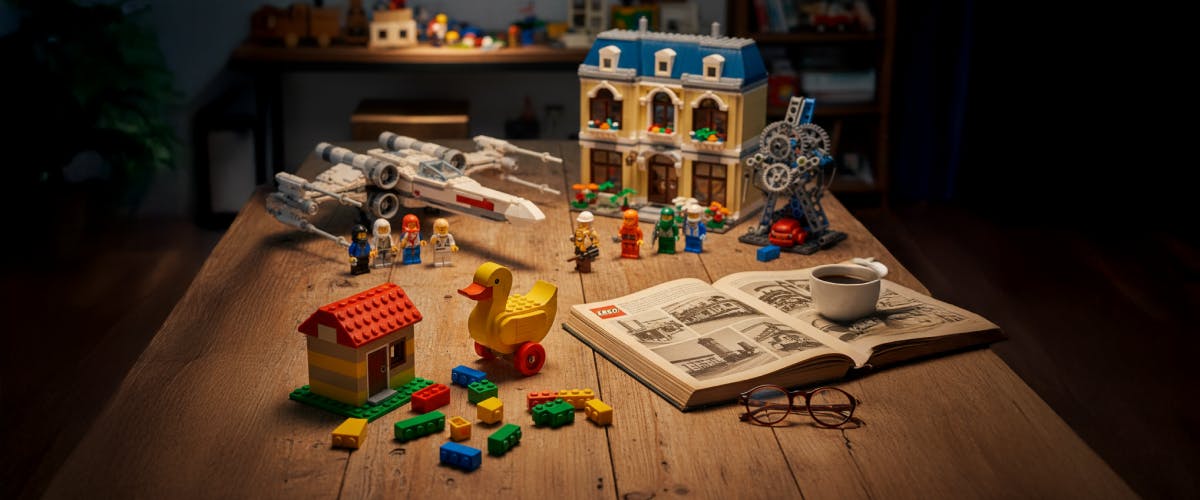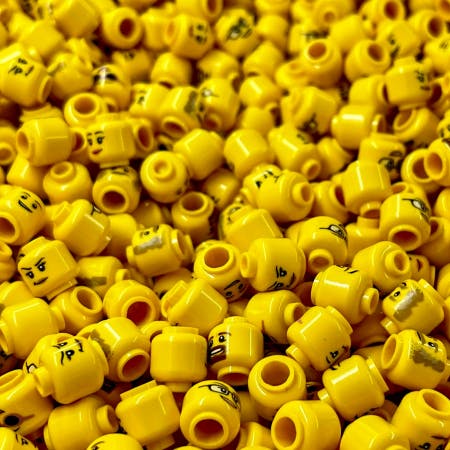belong to world
The LEGO paradox: one builds with one's own story
Business models are not a set, unchangeable truth, and every entrepreneur must consider a constant element of risk. But what really makes the difference? From crisis to success, here is how important fidelity to one’s own history is.

It is 1932 in Denmark, and a carpenter named Ole Kirk Christiansen begins producing small interlocking wooden toys. We are still far from what those wooden toys would become over time, but even then the heart of a story was already present that continues even today thanks to a simple insight: I am the protagonist of the act I perform, of the play to which I dedicate my time. In the 1950s the first turning point arrived for that reality, now a company, with a clear name: LEGO.
The name is a synthesis of a Danish phrase leg godt, “play well", and it is precisely starting from the name that a business model was born, based on activity carried out through bricks.
But we were talking about a turning point, and indeed that is what it was because, in the middle of the last century, the wooden bricks were transformed into plastic ones to the astonishment of all those who saw them come onto the market. The founder remained the protagonist of the brand, which at that point faced its first true crisis. People were not used to plastic; they were familiar with wooden toys, a material considered fine and valid.
But Christiansen wanted to make the play even more creative, placing people again in the center. The simplicity of production of plastic bricks allowed greater quantities of LEGO available for each player who could, in this way, move beyond standard forms and create something that was authentically the fruit of their imagination. The Danish carpenter went against everything and everyone, convinced that his idea was sincere and valid; unfortunately he did not survive to see the global success that his LEGO would reach. But things went exactly like that.
LEGO’s history has an opening that almost recalls a modern fairy tale: from its own know-how, its art, the insight is born followed by a proposal: to play. But even fairy tales are subject to change and evolution, and LEGO are no exception.


L’azienda si espande, il successo ormai è consolidato e lo è in maniera trasversale tra le generazioni. Piccoli e grandi usano i mattoncini per creare e anzi, sono proprio gli adulti che contribuiscono in misura maggiore alla ripresa dell’azienda dopo lo shock iniziale del passaggio alla plastica. Superato l’ostacolo, la leadership dell’azienda decide di rilanciare, osando in terreni fino ad allora inesplorati.
Negli anni ‘90, con il boom deThe company expanded; success by now was consolidated and cross-generational. Young and old used the bricks to create and, in fact, it is the adults who contributed most to the company’s recovery after the initial shock of transitioning to plastic. Having overcome the obstacle, the leadership of the company decided to relaunch, daring in areas until then unexplored.
In the 1990s, with the boom of video games and theme parks, LEGO also decided to follow the trend of diversification and launched clothing lines, strategic partnerships, theme parks and even jewelry. But the public did not respond as expected and LEGO went through another major crisis.
This crisis brought the company to the brink of bankruptcy: but for what reason? After all, the new business model was not so different from those that other companies were successfully adopting; just think of Disney, which made theme parks a substantial part of its business. Perhaps because, this time, it was not a change aligned with the product, but a true revolution that had lost contact with fundamental pieces. A paradox: LEGO in the 1990s had forgotten the heart of its own story, it had lost the bricks.
This part of the story has always been a great element of curiosity and fascination for us; the Teddy Group shares with LEGO that initial insight from a person - in our case, our founder Vittorio Tadei - but above all we share the same challenge: how to live change while remaining faithful to the heart of our history? Fashion is crossed by continuous trends, changes and revolutions that reflect the fabric of our territories to which we are constantly called to respond. But what makes it possible to truly embrace change, to look toward the future, evolving, but not betraying our deepest essence?
LEGO learned this at its own expense, but awareness and desire are, luckily, a solid base from which to restart. And even the brick brand began again from these two essential points. In 2017 the company chooses a new CEO, Niels Christiansen, and elects a new chairman in 2020, Thomas Kirk Kristiansen, from the fourth generation of the Christensens. Together they carry out a kind of counter-revolution: away with the superfluous, restart from our history.
The brick becomes protagonist again. But if you think that they simply removed the superfluous, you would be mistaken. The real challenge, one that anyone doing business shares, is to innovate while remaining true to oneself, but without cutting away aspects of reality. And so the new LEGO truly embraces the world of videogames, cinema, television series, but leaves protagonism and initiative to people. From this new awareness are born the LEGO sets dedicated to the most loved movies, to the most followed series and games by the public which whether from a small or large screen - bring into their homes, with their own creativity, the magic of their most beloved stories. i videogame e dei parchi a tema, anche Lego decide di seguire il trend della diversificazione e lancia linee di abbigliamento, partnership strategiche, parchi tematici e addirittura gioielli. Ma il pubblico non risponde come previsto e Lego attraversa una nuova grande crisi.
Questa crisi porta l’azienda a sfiorare il fallimento: ma per quale ragione? Il nuovo modello di business, dopotutto, non era così diverso da quello che altre aziende stavano portando avanti e con successo; basti pensare alla Disney che ha fatto dei parchi a tema una parte consistente del proprio business. Forse perché, questa volta, non si trattava di un cambiamento aderente al prodotto, ma di una rivoluzione vera e propria che aveva perso contatto con i tasselli fondamentali. Un paradosso: la Lego degli anni ‘90 aveva dimenticato il cuore della propria storia, aveva perso i mattoncini.
Questa parte della storia ha sempre costituito un grande elemento di curiosità e fascino per noi; il Gruppo Teddy condivide con Lego quell'intuizione iniziale da parte di una persone, nel nostro caso il nostro fondatore Vittorio Tadei, ma soprattutto condividiamo la stessa sfida: come vivere il cambiamento rimanendo fedeli al cuore della nostra storia? La moda è attraversata da continui trend, cambiamenti e rivoluzioni che riflettono il tessuto dei nostri territori a cui siamo costantemente chiamati a rispondere. Ma cosa rende possibile abbracciare davvero il cambiamento, guardare al futuro, evolvendo, ma non tradendo la nostra essenza più profonda?
Lego lo ha imparato a proprie spese, ma la consapevolezza e il desiderio sono, per fortuna, una base solida da cui ripartire. E anche il brand dei mattoncini è ripartito proprio da questi due punti essenziali. Nel 2017 l’azienda sceglie un nuovo amministratore delegato, Niels Christiansen, ed elegge un nuovo presidente nel 2020, Thomas Kirk Kristiansen, proveniente dalla quarta generazione dei Christensen. Insieme operano una sorta di controrivoluzione: via il superfluo, ripartiamo dalla nostra storia. Il mattoncino diventa di nuovo protagonista. Ma se pensate che si siano limitati ad eliminare il superfluo, commettete un errore. La vera sfida, quella che condivide chiunque faccia impresa, è quella di innovare, rimanendo fedeli a se stessi, ma non tagliando via aspetti della realtà. E così la nuova Lego abbraccia davvero il mondo dei videogame, del cinema, delle serie tv, ma lascia il protagonismo e l’iniziativa alle persone. Da questa nuova consapevolezza nascono i set Lego dedicati ai film più amati, alle serie e ai giochi più seguiti dal pubblico che, dallo schermo, piccolo o grande che sia, portano nelle loro case e con la propria creatività, la magia delle storie più amate.

Here is what fascinates us and what we seek to learn every day: to restart from one’s own story, to reclaim an insight, but to never stop looking at what happens around us. Because what truly inspires us, in LEGO’s story, is the courage to keep an identity without giving up change. It is the idea that one can innovate without uprooting, grow without forgetting. It is the continuous tension between memory and new possibility.
It reminds us that every day, even the most ordinary, is made of small “bricks” of meaning: relationships, gestures, insights, mistakes, choices. It is up to us to decide to use them to build, to connect, to imagine something new that however does not betray who we are. And this, for us at Teddy, is much more than a corporate principle: it is a way of approaching work. It is our way of “playing well".